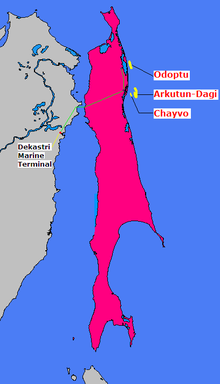Sakhalin-I
| Sakhalin-I project Chayvo, Odoptu, Arkutun-Dagi fields |
|
|---|---|
 |
|
| Country | Russia |
| Region | Sakhalin |
| Offshore/onshore | offshore |
| Operator | Exxon Neftegas Limited |
| Partners |
ExxonMobil Sakhalin Oil & Gas Development Co. Ltd. ONGC Videsh Ltd Sakhalinmorneftegas-Shelf RN-Astra |
| Production | |
| Current production of oil | 250,000 barrels per day (~1.2×107 t/a) |
| Estimated oil in place | 2,300 million barrels (~3.1×108 t) |
| Estimated gas in place | 17,100×109 cu ft (480×109 m3) |
The Sakhalin-I (Russian: Сахалин-1) project, a sister project to Sakhalin-II, is a consortium for a production of oil and gas on Sakhalin Island and immediately offshore. It operates three fields in the Okhotsk Sea: Chayvo, Odoptu, and Arkutun-Dagi.
In 1996, the consortium completed a production-sharing agreement between the Sakhalin-I consortium, the Russian Federation, and the Sakhalin government. The consortium is managed and operated by Exxon Neftegas Limited (ENL).
Since 2003, when the first Sakhalin-1 well was drilled, six of the world's 10 record-setting extended reach drilling wells have been drilled at the fields of the project, using the Yastreb rig. It has set multiple industry records for depth, rate of penetration and directional drilling. On 27 August 2012, Exxon Neftegas Ltd beat its previous record by completing Z-44 Chayvo well. This ERD well reached a measured total depth of 12,376 meters (40,604 ft), making it the longest well in the world.
Sakhalin I's fields Chayvo, Arkutun-Dagi and Odoptu were discovered by the Soviets some 20 years before the Production Sharing agreement of 1996. However these fields had never been properly assessed and a reevaluation of the commercial viability had to be carried out. To do this, factors such as the reservoir quality, producibility and well locations had to be found. 3-D seismic is the most common way to determine much of this however shallow gas reservoirs interfered with the seismic signals and blurred the images somewhat.
Two campaigns of 3-D seismic was carried out along with a number of appraisal wells into the Arkutun-Dagi and Chayvo fields. The results were initially average from the appraisal wells with hydrocarbons being successfully tested, but there was a still a large amount of uncertainty involved with the project. However, in late 1998, a revaluation of the 3-D seismic data using the most advanced seismic-visualization techniques then available indicated that the hydrocarbon depth on the edge of the field could be significantly deeper than first thought. In 2000, the Chayvo 6a delineation well confirmed what was suspected, a 150 meters (490 ft) oil column. This provided the certainty that the field was commercially viable in the hostile environment with a potential to be a 1-billion-barrels (160×106 m3) field.
...
Wikipedia
